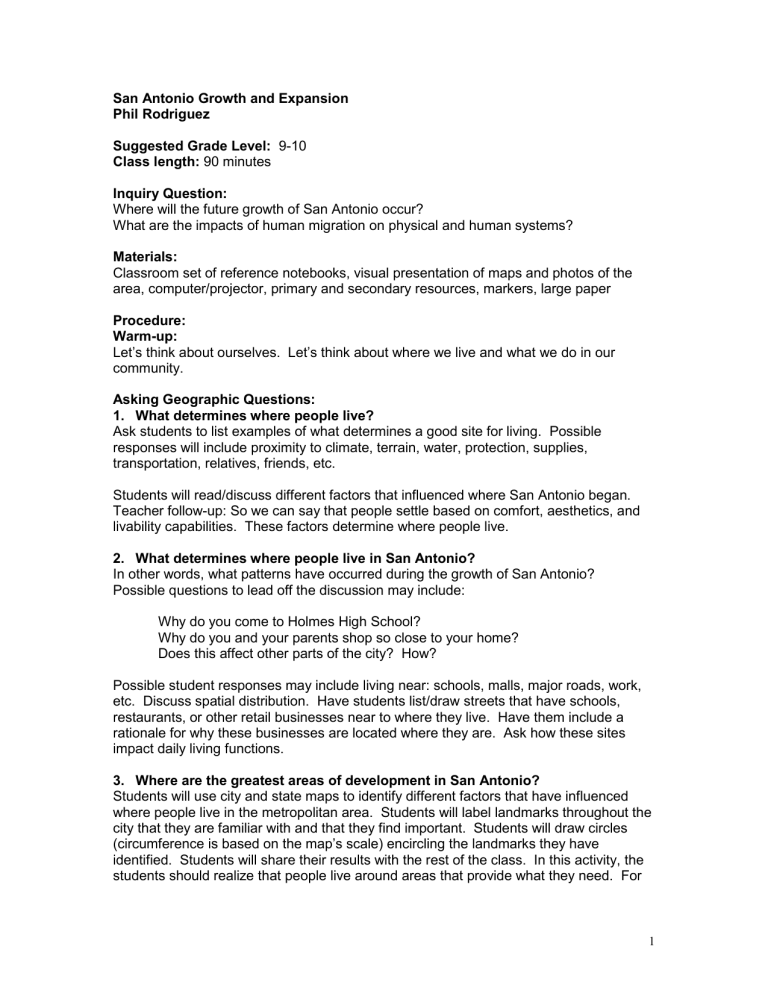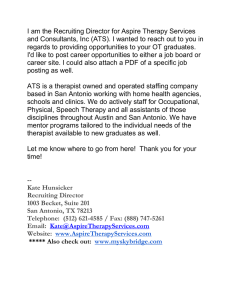San Antonio Growth and Expansion Phil Rodriguez Suggested Grade Level:

San Antonio Growth and Expansion
Phil Rodriguez
Suggested Grade Level: 9-10
Class length: 90 minutes
Inquiry Question:
Where will the future growth of San Antonio occur?
What are the impacts of human migration on physical and human systems?
Materials:
Classroom set of reference notebooks, visual presentation of maps and photos of the area, computer/projector, primary and secondary resources, markers, large paper
Procedure:
Warm-up:
Let’s think about ourselves. Let’s think about where we live and what we do in our community.
Asking Geographic Questions:
1. What determines where people live?
Ask students to list examples of what determines a good site for living. Possible responses will include proximity to climate, terrain, water, protection, supplies, transportation, relatives, friends, etc.
Students will read/discuss different factors that influenced where San Antonio began.
Teacher follow-up: So we can say that people settle based on comfort, aesthetics, and livability capabilities. These factors determine where people live.
2. What determines where people live in San Antonio?
In other words, what patterns have occurred during the growth of San Antonio?
Possible questions to lead off the discussion may include:
Why do you come to Holmes High School?
Why do you and your parents shop so close to your home?
Does this affect other parts of the city? How?
Possible student responses may include living near: schools, malls, major roads, work, etc. Discuss spatial distribution. Have students list/draw streets that have schools, restaurants, or other retail businesses near to where they live. Have them include a rationale for why these businesses are located where they are. Ask how these sites impact daily living functions.
3. Where are the greatest areas of development in San Antonio?
Students will use city and state maps to identify different factors that have influenced where people live in the metropolitan area. Students will label landmarks throughout the city that they are familiar with and that they find important. Students will draw circles
(circumference is based on the map’s scale) encircling the landmarks they have identified. Students will share their results with the rest of the class. In this activity, the students should realize that people live around areas that provide what they need. For
1
example, malls, schools, and churches are built near areas that have clusters of neighborhoods or areas of soon-to-come subdivisions.
This will lead to a discussion about “cities within cities” style of living. Many people live within a certain area that will provide them with most necessities. They will leave those bounds when their communities cannot meet specific needs.
4. How is the pattern of population growth changing San Antonio?
Movement is occurring to suburban areas and small surrounding towns. This phenomenon, as well as the “pepperoni pizza model” (from H.J. de Blij) of urban growth has led people away from the center part of San Antonio. Have the students write reasons for movement from the city of San Antonio. Reasons they give will probably be based on comfort, aesthetics, and livability capabilities (discussed at a previous question). Reiterate that, regardless of time, voluntary movement is usually based on these factors. Give each pair of students a copy of the instructions for this activity, data recording sheets, and a reference notebook of reading and census materials. Briefly go over the instructions as a class and answer any questions about the procedures that students might have.
5. How are outlying towns affecting the growth of San Antonio?
When the students have had an opportunity to skim through the reference notebook and draw out the pertinent information, they will begin the process of analyzing the information needed to determine the effects that small towns may have on a large city.
Students will draw concentric circles to show movement between surrounding towns and
San Antonio, record, and explain what the data shows (data show that many residents of small towns may actually work in San Antonio). From this, students will be able to infer how these towns affect San Antonio.
6. Inquiry Question: Where will the future growth of San Antonio occur ?
The students, based on their inferences, will shade a map which will show the counties that they feel will receive future population growth flow from San Antonio. They will show on what they base their findings.
Student results will vary. Most will find that growth is toward the north, northwest, and northeast of San Antonio and the surrounding area. Their results will be based on census data retrieved from the 1990 census (some 2000 data is presently not completely ready for publication).
Evaluation:
After completing the activity and class discussion, each student will turn in their maps, charts, tables, a rationale for their conclusion as well as references that support their conclusion. And lastly, they will be assessed on their participation in the class activity.
2





